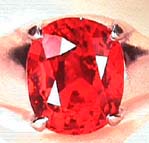The Story of Ruby Gemstones

Ruby
Consumer Information
What color is it?: Red. Not reddish purple, not pink, and not sort of red. Rubies are red, red, red. Any other color is a sapphire…which is the name for all other colors of corundum.
What is the story behind this gemstone?: Perhaps the most famous of the Big Four of what was once called precious stones: diamonds, emeralds, sapphires and rubies. The gemstone of kings. And one of the rarest gemstones on the earth.
Can I wear it everyday?: Absolutely. Ruby is second only to diamond in hardness. And wears very well for everyday.
Is it expensive?: Yes. Rubies of natural color and high quality are very, very expensive. There are some grades that are fairly heavily included that are much less expensive. But a fine quality ruby will cost a dear price.
Is it a birthstone?: Yes, July.
What do I need to know before going shopping?: First, many rubies being offered in the discount stores and department stores…and in fact a lot of the mall jewelry stores….are synthetic. Most will properly tell you that the stones are “laboratory created” which is a creative way of telling you they are synthetic. These synthetics are very difficult to identify. But…. more than one discount jeweler has been found to be selling synthetic rubies as natural. So stay with a professional, independent retail jeweler with a qualified gemologist and gemological laboratory on site. Second, the vast majority of stones sold as “rubies” are actually “purple sapphires” with some pink or red overtones. Rubies are red. Sapphires are reddish purple. And while it may appear that the strong purple overtones still make a ruby, the prices are no where near as expensive as true rubies. So remember that a ruby is red, red, red when you shop. Not purple, not pink and not “sort of” red. Don’t let them charge you a ruby price for a sapphire stone. And third, most rubies are heat treated to improve color. This is considered the continuation of a natural process that occurs in the earth. However, heat treated rubies will be less expensive than natural color rubies. In fact, natural colors could be thousands of dollars per carat more than a treated stone. So if you are going to spend some serious money on a ruby get a proper gemological grading report from a major gemological laboratory. There are a lot of treatments on rubies that are very, very difficult to identify even by well experienced gemologists.
General Information
A natural hexagonal ruby crystal in green zoisite. Photo courtesy of Robert Connelly, Sao Paulo, Brazil
Source: Burma, Sri Lanka, Thailand, Viet Nam, Brazil, and others
Chemical: Al2O3 Aluminum oxide just like a sapphire, both are corundum.
Formation: In igneous rocks like the zoisite above. The hexagonal shape of the crystal in this photograph is the natural shape of a ruby crystal as seen down the “C” axis, or long direction, of the crystal.
Crystal System: Hexagonal. The photo above is a very classic look at a hexagonal crystal. Thanks, Robert Connelly. Well done on this photograph.
Unusual Properties: Can have asterism (star as shown below), chatoyancy (cat’s eye) and other phenomenon
Gemological Information
RI: 1.762 – 1.770
Birefringence: .008
Optic Character: U –
Specific Gravity: 4.00
Hardness: 9
Transparency: O-TP
Special Identifying Properties and Tests: Must be specifically and intensely red with very minor modifying colors. Chromium spectra evident in most stones.
Synthetics: Yes, Curved striations in flame fusion. Fluorescence is important test as natural ruby will have a higher content of iron which will have the effect of keeping FL reaction to a minimum, while synthetic ruby will react with a bright red to long and/or short wave UV due to absence of iron in most stones. FL should be used in conjunction with other tests. Window blind effect will be seen in Cambodian ruby. Be suspect of Vietnamese stones as mines were once reported to be salted with synthetic crystals. Separation of natural from synthetic ruby is very difficult and should be done by major laboratory for larger stones of high value.
Imitations: Many and varied.

